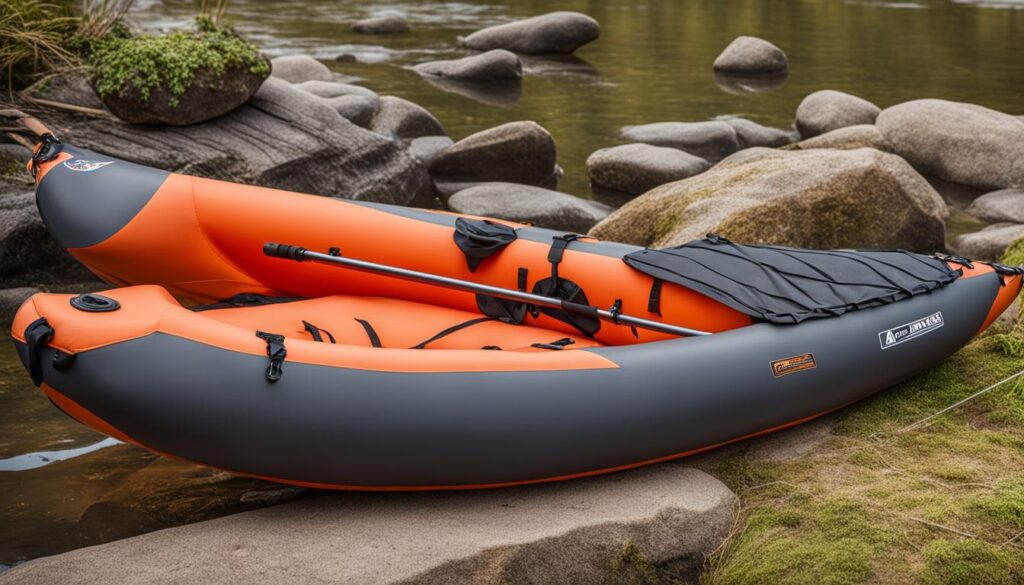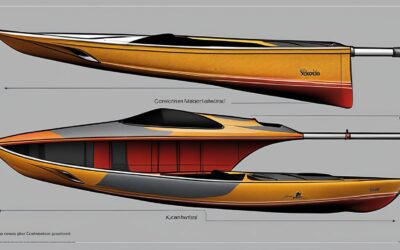Inflatable kayaks have gained popularity for their portability and ease of use. However, their durability is often questioned in comparison to hardshell kayaks. If you’re considering investing in an inflatable kayak, it’s important to understand their durability and longevity. In this article, we will explore the factors that contribute to the durability of inflatable kayaks and provide insights into their wear resistance.
Key Takeaways:
- Inflatable kayaks are designed to withstand rocks, limbs, and debris, making them a durable choice for kayaking.
- The construction and materials used in the kayak, such as PVC and drop-stitch construction, play a significant role in determining its durability.
- Proper maintenance and care, along with following inflation and deflation guidelines, can impact the overall durability and longevity of an inflatable kayak.
- Real-life durability tests have shown that high-quality inflatable kayaks made with durable materials can withstand tough conditions.
- By following proper care and maintenance guidelines, owners can increase the longevity and durability of their inflatable kayaks.
Determining Inflatable Kayak Durability
Inflatable kayaks are designed to be durable and able to withstand various conditions, but their longevity and overall durability can vary depending on several factors. Understanding the construction and features of inflatable kayaks is essential in determining their durability.
Inflatable Kayak Construction
The construction of an inflatable kayak plays a significant role in its durability. High-quality inflatable kayaks are made using strong materials and advanced manufacturing processes. PVC, Hypalon, and Nitrylon are commonly used materials known for their durability and resistance to punctures and abrasions. Drop-stitch construction, which involves stitching the top and bottom layers of the kayak together with thousands of interconnected threads, enhances the kayak’s rigidity and strength. This construction method ensures that the kayak maintains its shape and durability even under pressure.
Durability Features of Inflatable Kayaks
In addition to the materials used, inflatable kayaks often incorporate specific features that enhance their durability. Reinforced seams and multiple air chambers are common design elements that provide added strength and stability. Reinforced seams prevent air leaks and potential tears, while multiple air chambers ensure that even if one chamber gets punctured, the kayak remains afloat. These durability features are crucial for ensuring the kayak’s safety and longevity during use.
Inflatable Kayak Lifespan
The lifespan of an inflatable kayak can vary depending on its construction, usage, and maintenance. A well-made and properly cared for inflatable kayak can last for many years of regular use. Regular inspections for signs of wear and tear, proper cleaning and drying after each use, and following inflation and deflation guidelines are all essential for maintaining the kayak’s durability over time. Protecting the kayak from excessive exposure to UV rays and storing it in a cool, dry place can also help extend its lifespan.
| Inflatable Kayak Durability Factors | Durability Features |
|---|---|
| Construction Materials | PVC, Hypalon, Nitrylon |
| Construction Method | Drop-stitch construction |
| Reinforced Elements | Seams, multiple air chambers |
| Lifespan Factors | Proper usage, maintenance, storage |
By considering the construction, durability features, and lifespan factors of inflatable kayaks, you can make an informed decision when choosing a kayak that will withstand the test of time and provide enjoyable adventures on the water.
Benefits and Drawbacks of Inflatable Kayaks
Inflatable kayaks offer several advantages that make them a popular choice for kayakers. First and foremost, their portability is a major advantage. Inflatable kayaks are lightweight and easy to carry, making them ideal for people who enjoy kayaking in different locations or traveling to their favorite kayaking destinations. Their compact size when deflated also allows for easy storage in small spaces, such as closets or the trunk of a car. Additionally, inflatable kayaks are generally more affordable than hardshell kayaks, making them a cost-effective option for those on a budget.
However, it’s important to consider the drawbacks of inflatable kayaks as well. One significant drawback is their susceptibility to punctures. While quality inflatable kayaks are designed to be resistant to punctures and tears, they are still more vulnerable compared to hardshell kayaks. It’s crucial to exercise caution and avoid sharp objects or rough surfaces that could potentially damage the kayak. Another drawback is that inflatable kayaks may not provide the same level of stability as hardshell kayaks, especially in rough waters. Their lightweight construction can make them more susceptible to tipping or swaying, requiring the kayaker to have good balance and control.
When deciding on an inflatable kayak, it’s essential to weigh the benefits against the drawbacks. If portability, affordability, and ease of storage are significant factors for you, then an inflatable kayak may be the perfect choice. However, if stability and durability in rough conditions are your primary concerns, a hardshell kayak may be a better option. By understanding the advantages and disadvantages of inflatable kayaks, you can make an informed decision that suits your kayaking needs and preferences.
Advantages of Inflatable Kayaks
- Portability: Lightweight and easily transportable.
- Cost-effective: Generally more affordable than hardshell kayaks.
- Easy storage: Compact size when deflated.
Disadvantages of Inflatable Kayaks
- Susceptible to punctures: More vulnerable compared to hardshell kayaks.
- Less stability: Lightweight construction may result in less stability, particularly in rough waters.
Understanding the benefits and drawbacks of inflatable kayaks can help you make an informed decision when choosing the right kayak for your needs. Consider your kayaking preferences, the environments you plan to kayak in, and the level of durability and stability you require. By doing so, you can select the kayak that will provide you with the most enjoyable and safe kayaking experiences.
Factors Affecting the Durability of Inflatable Kayaks
When it comes to the durability of inflatable kayaks, several factors come into play. The material used, the construction of the kayak, and proper usage and maintenance all contribute to its overall durability and longevity.
The material of the inflatable kayak plays a crucial role in determining its resistance to punctures, abrasions, and UV rays. Common materials used include PVC, Hypalon, and Nitrylon. PVC is widely used due to its durability and affordability, while Hypalon and Nitrylon offer increased resistance to UV rays and chemicals, making them suitable for more challenging environments.
The construction of the kayak also plays a significant role in its durability. Quality inflatable kayaks have solid seam construction, reinforced chambers, and durable valves to ensure airtightness and prevent leaks. Additionally, kayaks with multiple air chambers provide added safety, as even if one chamber gets punctured, the kayak will remain afloat.
Proper usage and maintenance are essential for preserving the durability of inflatable kayaks. Following the manufacturer’s guidelines for inflation and deflation, as well as cleaning and drying the kayak after each use, helps prevent damage and prolong its lifespan. Proper storage, preferably in a cool, dry place away from direct sunlight, also helps maintain the kayak’s overall durability.
Table: Comparison of Inflatable Kayak Materials
| Material | Durability | Resistance to UV Rays | Resistance to Chemicals | Price Range |
|---|---|---|---|---|
| PVC | Good | Fair | Good | Affordable |
| Hypalon | Excellent | Excellent | Excellent | High-end |
| Nitrylon | Excellent | Excellent | Excellent | High-end |
By considering the material, construction, and proper usage and maintenance of an inflatable kayak, you can ensure its durability and longevity. Investing in a high-quality kayak made with durable materials and proper construction techniques will provide you with a reliable and long-lasting vessel for your kayaking adventures.
Real-Life Durability Tests of Inflatable Kayaks
In order to determine the durability of inflatable kayaks, real-life tests have been conducted to subject them to various challenging conditions and evaluate their performance. These tests aim to simulate the wear and tear that kayaks may experience during regular usage, as well as their ability to withstand unexpected incidents.
One key aspect of durability testing is assessing the kayak’s resistance to punctures and abrasions. In this regard, kayaks are dragged over rocks, exposed to sharp objects, and pushed against rough surfaces. The ability of the kayak’s material, construction, and design features to withstand these conditions is carefully examined. The results of these tests help determine which kayaks are more likely to endure and maintain their structural integrity over time.
Real-life durability tests have shown that high-quality inflatable kayaks made with durable materials and construction techniques can withstand tough conditions and remain resistant to damage.
Another important element of durability testing is evaluating the kayak’s resistance to UV rays. Inflatable kayaks are often used in outdoor settings where they are exposed to sunlight for extended periods. The impact of UV rays on the kayak’s material, color, and overall performance is assessed to determine the extent to which it can withstand prolonged sun exposure without significant degradation.
Overall, real-life durability tests provide valuable insights into the performance and longevity of inflatable kayaks. The results help consumers make informed decisions when selecting a kayak that meets their durability requirements and ensures a reliable and enjoyable kayaking experience.
| Test Parameters | Results |
|---|---|
| Resistance to punctures and abrasions | Inflatable kayaks made with high-quality materials and strong construction techniques demonstrated excellent resistance to punctures and abrasions. |
| UV resistance | The majority of inflatable kayaks tested showed good resistance to UV rays, maintaining their color and structural integrity with minimal signs of degradation. |
| Impact resistance | Well-designed inflatable kayaks with reinforced seams and chambers proved highly resistant to impacts and maintained their structural integrity even when subjected to rough conditions. |
| Longevity | High-quality inflatable kayaks that passed durability tests are expected to provide years of reliable performance when properly used, maintained, and repaired if necessary. |
Tips for Increasing the Durability of Inflatable Kayaks
In order to maximize the durability and lifespan of your inflatable kayak, it is important to follow proper maintenance and care guidelines. By taking a few simple steps, you can ensure that your kayak remains in great condition for years to come.
Regular Inspection and Repair
Performing regular inspections of your inflatable kayak is essential to catching any signs of wear and tear early on. Check for any punctures, abrasions, or damage to the seams, valves, and chambers. If you notice any issues, it is important to repair them promptly using recommended patch kits. This will prevent further damage and extend the life of your kayak.
Cleaning and Drying
After each use, make sure to thoroughly clean your inflatable kayak with mild soap and water. This will remove any dirt, salt, or debris that can cause damage over time. Additionally, be sure to completely dry your kayak before storing it. Excess moisture can lead to mold and mildew growth, which can weaken the material and compromise the durability of your kayak.
Proper Storage
Storing your inflatable kayak properly is crucial for maintaining its durability. Store it in a cool, dry place away from direct sunlight and extreme temperatures. Avoid folding or creasing the kayak excessively, as this can weaken the material. If possible, store your kayak in a protective bag or cover to shield it from dust and potential damage.
By following these tips for inflatable kayak maintenance and care, you can significantly increase the durability and lifespan of your kayak. With proper maintenance, your inflatable kayak will continue to provide you with countless adventures on the water.
Conclusion
Inflatable kayaks can provide exceptional durability when made with quality materials and construction techniques. The longevity and overall durability of these kayaks are influenced by various factors including the materials used, the construction process, and proper usage and maintenance.
Real-life durability tests have demonstrated that high-quality inflatable kayaks can withstand tough conditions, such as dragging over rocks, exposure to sharp objects, and UV rays. These tests validate the durability of well-made inflatable kayaks, reinforcing their ability to remain resistant to damage.
By following proper care and maintenance guidelines, you can significantly increase the lifespan and durability of your inflatable kayak. Regular inspection for signs of wear and tear, proper cleaning and drying, and following inflation guidelines are essential practices to ensure your kayak maintains its durability over time.
Ultimately, inflatable kayaks can offer years of enjoyable and adventurous experiences when treated with care. With attention to quality construction, proper usage, and regular maintenance, you can maximize the longevity of your inflatable kayak and continue to explore the waters with confidence.
FAQ
Are inflatable kayaks durable?
Yes, inflatable kayaks are designed to withstand rocks, limbs, and debris. Quality inflatable kayaks are resistant to punctures and tears, making them a durable choice for kayaking.
What factors influence the durability of inflatable kayaks?
The construction of the kayak, including the materials used and the manufacturing process, plays a significant role in determining its durability. The lifespan of an inflatable kayak can also depend on the quality of the materials used in its construction, such as PVC, Hypalon, or Nitrylon. Additionally, proper maintenance and care, as well as the frequency and type of use, can impact the overall durability and longevity of an inflatable kayak.
What are the advantages and disadvantages of inflatable kayaks?
Inflatable kayaks offer several advantages, including portability, cost-effectiveness, and ease of storage. They are lightweight, easily deflatable, and can be stored in compact spaces. However, they are more susceptible to punctures and less stable in rough waters compared to hardshell kayaks. In terms of speed, inflatable kayaks may be slower due to their lightweight construction. It is important to consider both the advantages and disadvantages when assessing the overall durability of inflatable kayaks.
What factors affect the durability of inflatable kayaks?
Several factors affect the durability of inflatable kayaks. The material used, such as PVC, Hypalon, or Nitrylon, determines its resistance to punctures, abrasions, and UV rays. The construction, including the quality of seams, valves, and chambers, can impact its overall durability. Proper usage and maintenance, such as following inflation and deflation guidelines, cleaning and drying after use, and storing the kayak properly, contribute to its longevity.
Have real-life durability tests been conducted on inflatable kayaks?
Yes, real-life durability tests have been conducted to assess the durability of inflatable kayaks. These tests involve subjecting the kayaks to various conditions, including dragging them over rocks, exposing them to sharp objects, and testing their resistance to UV rays. Results have shown that high-quality inflatable kayaks made with durable materials and construction can withstand these tests and remain durable and resistant to damage. Proper repairs using recommended patch kits can also extend the lifespan of an inflatable kayak.
What tips can increase the durability of inflatable kayaks?
Proper maintenance and care are crucial for increasing the durability of inflatable kayaks. This includes regular inspection for signs of wear and tear, proper cleaning and drying, following inflation guidelines, and using protective gear such as kayak covers and spray skirts. Storing the kayak in a cool, dry place away from direct sunlight and extreme temperatures also helps maintain its durability. By following these tips, owners can prolong the lifespan of their inflatable kayaks and ensure they remain durable throughout their usage.







